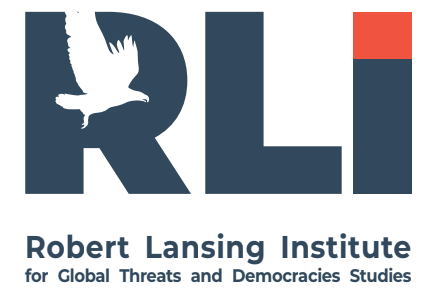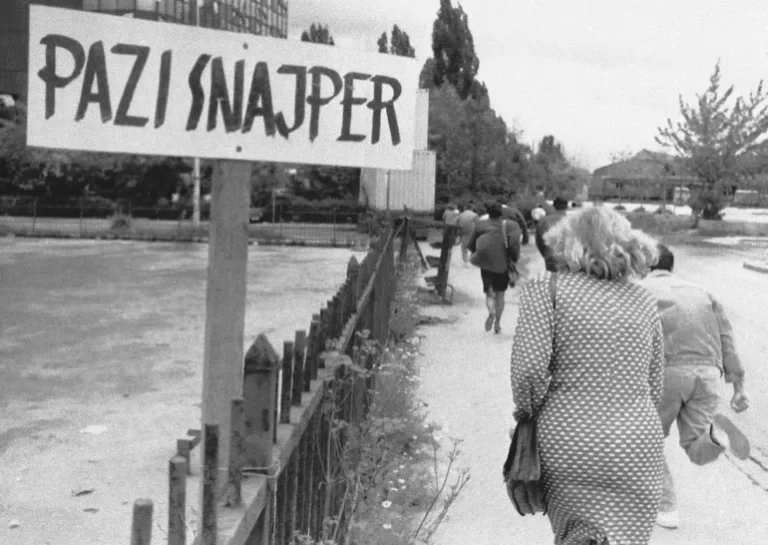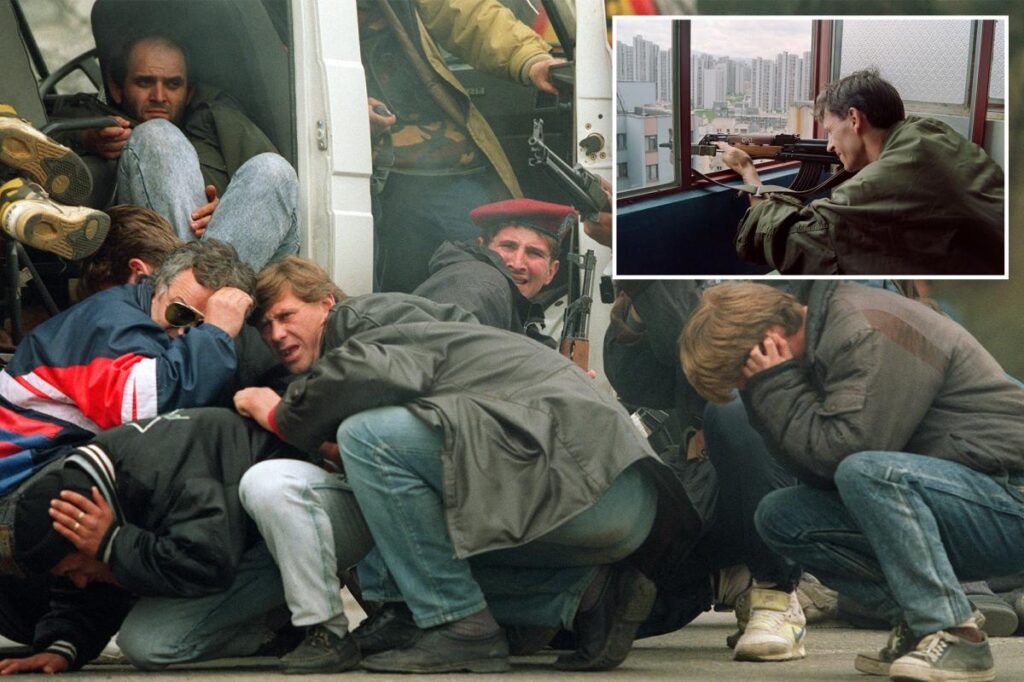The Siege of Sarajevo (1992-1996) remains one of the most prolonged and devastating urban blockades in modern European history. Bosnian Serb forces encircled the city for nearly four years, deploying heavy artillery and sniper fire that terrorized civilians daily (Burg & Shoup, 1999; HRW, 1994). The elevated hills surrounding Sarajevo gave snipers a clear line of sight into the city, turning streets, crosswalks, and open areas into lethal zones.
In recent years, allegations have arisen that wealthy foreign nationals paid Bosnian Serb forces to facilitate “sniper tourism,” allowing them to shoot civilians for recreation. Reports mention sums like €80,000-€100,000 per trip and even a “price list” for different categories of victims, such as children. However, these remain unverified claims, lacking publicly accessible judicial or archival confirmation (The Guardian, 2025). This critically situates those allegations within the historical context of sniper warfare, the paramilitary and ideological infrastructure of war, and the political networks of figures like Aleksandar Vučić and Vojislav Šešelj. By doing so, it assesses both the plausibility of the claims and their broader moral and legal implications.
Historical context of Sniper Warfare during the Siege
From early April 1992, Sarajevo was under constant assault. Bosnian Serb forces not only shelled the city but also strategically deployed snipers to target civilians, creating an omnipresent threat. According to UN/peacekeeping reports, sniper fire was a daily hazard, with civilians forced to use covered or indirect routes to avoid exposure (.
Human Rights Watch documented numerous cases where civilians- women, children, the elderly, were deliberately targeted by snipers, contributing to a climate of terror (HRW, 1994).
A detailed post-war report (“MEMORIJA Edition”) draws on UN testimonies and trial judgments to show that sniper attacks were often deliberate, not accidental: snipers positioned on the hills fired at civilian objects and individuals, not just military targets.
Medical studies from the siege provide further confirmation of sniper violence. In one peer-reviewed emergency medical report, researchers documented that across 18 months, nearly 81% of reported casualties from sniper and shelling incidents were civilians (emergency services report, May 1993) (Zalokar‑Milutinović et al., 1993).
Early observations and risk dynamics
International observers frequently noted how the elevated terrain around Sarajevo made civilian movement especially dangerous. In 1993, UNFOR (United Nations Protection Force) reported “sporadic sniper fire” overnight in certain districts, including areas near where civilians gathered or moved .
These facts show that sniping was not random crossfire but an integrated component of the siege strategy, designed to control the population, limit movement, and inflict psychological as well as physical damage.
Political and paramilitary structures- Vučić, Šešelj, and the White Eagles
Now Serbian President, Aleksandar Vučić entered politics during this turbulent period. In 1993, he joined the Serbian Radical Party (SRS), a nationalist party founded and led by Vojislav Šešelj (Jovanović, 2021). intapi.sciendo.com Within two years, Vučić became Secretary-General of the SRS, placing him at the heart of the party organization (Istinomer, n.d.).
Academic analysis shows that Vučić’s role was not merely administrative. He helped shape the party’s ideological messaging and was deeply embedded in its radical nationalist agenda (Jovanović, 2021).\ Some sources also suggest he visited front-line units during the war, though there is no credible, publicly documented evidence tying him to operational control of paramilitary forces.
Vojislav Šešelj and the White Eagles
Vojislav Šešelj was the ideological and political leader of the SRS, and he maintained influence over paramilitary formations. One of the most infamous was the White Eagles (Beli Orlovi), which operated in Bosnia, Croatia, and other regions during the wars.
These formations did not always answer to a unified chain of command, but they were ideologically aligned with Šešelj’s vision of so-called ‘greater Serbia’. Historians note that, through the SRS, Šešelj provided a political-ideological framework for recruitment, logistical support, and moral justification of violent activities (Flottau, 2009).
Šešelj’s dual role as a parliamentary political actor and as a paramilitary patron, created a network in which extremist violence could be legitimated and maintained, particularly during the early to mid‑1990s.
Allegations of “Sniper Safaris”- Origins and nature of the claims
The most widely reported source of the “sniper tourist” allegations are the 2022 documentary Sarajevo Safari, directed by Miran Zupanič. The film includes testimonies from former Bosnian Serb combatants, intelligence personnel, and others who claim that wealthy foreign civilians were brought to sniper positions to shoot at Sarajevo’s residents for “sport.”
Some of these testimonies refer to an alleged “price list,” where different categories of civilians- children, men in uniform, women, the elderly, were assigned different monetary values. As of now, these remain unverified, as no publicly available judicial or archival records have confirmed a formal “tourism sniper program.”
Journalistic reporting (e.g., The Guardian, 2025) notes that Milan prosecutors have opened an investigation into these claims, but emphasize that no public indictments or convictions have yet been reported.
Assessment of plausibility
While the “sniper safari” claims are extraordinary and deeply disturbing, they must be viewed through a critical framework:
Contextual plausibility: The structures required to facilitate such excursions, paramilitary groups, ideological networks, command links- were indeed present. According to Institute for War and Peace Reporting (IWPR), a former SRS volunteer testified that Šešelj “controlled” SRS volunteers during the war, providing salaries, leave, and pensions.
Lack of verification: Despite the documentary and journalistic reports, there is no open-source public court case that confirms the payment schemes, target price lists, or tourist identities. This absence of tangible evidence suggests the need for caution.
Narrative risk: If these claims are accepted without sufficient proof, they may overshadow other verified war crimes, or be manipulated for political ends.
Legal and ethical implications
Under international law, deliberate targeting of civilians during an armed conflict constitutes war crimes and possibly crimes against humanity (IRMCT / ICTY jurisprudence). Sniper attacks that aim at non-combatants clearly fall under those categories.
If “sniper tourist” excursions were proven, they might also implicate command responsibility. Political or military leaders who facilitated or turned a blind eye to such practices could be held accountable (IRMCT, residual mandate of the ICTY).
From an ethical standpoint, these allegations raise horrendous questions about the commodification of violence: paying to kill civilians for pleasure would represent a deeply perverse commercialization of war.
Even if the sniper safari allegations remain unproven, they have symbolic power. They force a reckoning with how extremist ideology, privilege, and violence intersect. Survivors may find in these claims a moral mirror: whether or not true, the possibility of “human hunting” underscores the inhumanity many already felt during the siege.
Politically, revisiting these claims touches on narratives of state responsibility, nationalism, and post-war reconciliation. Investigations- even if not fully substantiated, can play an important role in historical memory, pushing societies to confront painful possibilities rather than erase or sanitize them.
Challenges to historical reconstruction and accountability
Archival and Investigative Gaps: Many relevant documents may be missing, destroyed, or remain classified. Paramilitary records, internal SRS documentation, and intelligence files from the 1990s are not fully accessible, making reconstruction difficult. Researchers face both legal and practical barriers.
Potential witnesses: Former soldiers, intelligence operatives, or civilians, may be deeply traumatized or fear retaliation. Their testimony might surface only if protections, anonymity, and psychological support are guaranteed.
Cross-Border Legal Hurdles: If such claims are ever pursued judicially, they would likely require international cooperation. Extradition, mutual legal assistance, and joint investigative mechanisms will be essential. But political will may be limited, especially if high-level or intelligence actors are implicated.
Narrative and political risks: Focusing heavily on “sniper tourism,” especially in the absence of hard proof, could distort public discourse. There is a risk that sensational claims distract from other documented war crimes. Moreover, political actors may use the narrative tactically, either to deflect responsibility or to inflame nationalist sentiment.
The Siege of Sarajevo remains an emblematic episode of wartime suffering, where sniper fire was a tool not just of military strategy but of terror and control. The allegations of “sniper safaris”- foreign tourists paying to hunt civilians are deeply shocking, and if ever proven, would represent an even darker chapter in the conflict.
Yet, because these claims remain unverified, they must be handled with scholarly care. The power of the narrative lies in its resonance: it forces a confrontation with how ideology, privilege, and violence might have converged in grotesque ways. At the same time, it underscores the need for rigorous investigation, accountability, and moral reckoning.
Ultimately, even in the absence of definitive proof, the possibility of such atrocities demands attention. It invites us to reflect on the structures that made wartime violence possible and to consider how memory, justice, and truth should shape post-conflict reconstruction.





